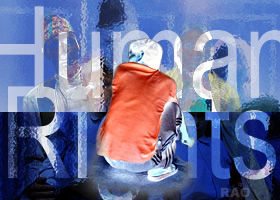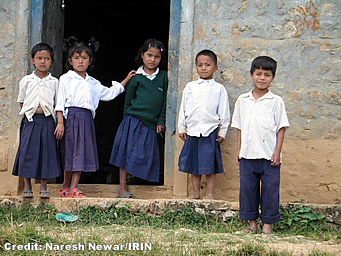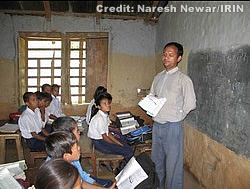|
Nepal
in Crisis 2006: Human Rights
|
|
Decades
of damage to education
|
 |
Kathmandu,
02 February 2006 (IRIN)
The
climate in schools for many children is one of fear, both of abductions
by Maoist rebels and of the soldiers stationed outside schools by the security
forces. The lack of teachers in schools also means that many classes
are not held.
 |
| The
decision in late November 2005 by Nepal's Maoist rebels to form an alliance
with the main political parties against King Gyanendra, has met with muted
enthusiasm from many Nepalis, in particular teachers and school students
who say that even if peace does come to the Himalayan kingdom, it will
take years for Nepal to put its education sector right again. |
|
"The
situation with regard to education has become so bad that it will take
several decades to restore what we had achieved before the conflict started,"
said Dipendra Roka, a schoolteacher in Salle village in Rukum district,
about 300 km northwest of the capital, Kathmandu.
 |
|
| Like
many rural hill districts, Rukum has experienced very low school
attendance since the conflict started, due to abductions by rebels who
have often forced students and teachers to march to the remotest parts
of the district to attend their cultural and "revolutionary orientation"
programmes.
Most
schools in the district are also running out of books, other teaching materials
and even decently-built classrooms, as
the government has failed to use the education budget to maintain infrastructure
and supplies, local teachers say. |
|
According
to the United Nations Children's Fund, Nepal has an adult literacy rate
of only 42 percent. The percentage of illiterate females, it says, is far
higher.
| High
Drop Out Rate |
 |
Although
82 percent of children are officially enrolled at Nepal's schools nationally,
almost half of them are reported by NGOs to drop out of school during the
first two years. Nearly three-quarters
leave before the completion of primary school. Only around 10 percent complete
secondary school education.
 |
| Due
to a lack of government presence in most rural areas, regional education
offices in Rukum, Rolpa, Kalikot and several other Maoist-controlled
districts, especially in west Nepal, have not been able to implement
their education programmes according to the national curriculum.
"Many
children in the villages are dropping out of schools due to a lack of teachers
and proper education materials. The conflict
has been the main cause," added Roka, who worked as a Maoist cadre for
two years after the rebels forced him to join their ranks. |
|
His
main job was to visit schools and expose both teachers and students to
the Maoists' ideology. Five months ago, he escaped and took refuge
in a district centre, where he now works at the high school. He fears for
his life: if Maoist insurgents find him, he says he will be executed for
desertion.
| Teachers
have been especially targeted in the conflict |
 |
Since
the conflict began in Nepal in February 1996, teachers in the villages
have been targeted by both the rebels and the security forces.
According to the Informal Sector Service Centre (INSEC), a leading Nepali
human rights group, at least 141 teachers
have been killed during the conflict - 84 by the rebels, and the rest by
the security forces.
 |
| < Teachers have been especially targeted in the conflict, allegedly by both
rebels and the army. Narjit Basnet's hand was chopped off by Maoist rebels.
He still manages to teach the children at a community school.
"These
attacks on teachers are meant to lead to the control of the education system,
to use it to indoctrinate children," said Keshab Bhattarai, president of
the Teachers' Union of Nepal.
Around
19,000 public primary schools in the rural areas serve nearly 3.4 million
children. |
|
Schools have shut down when rebels wanted to pressure the government
to release rebel cadres, or force some other concession from the Kathmandu
government.
Maoists
attack the security forces.
According
to a 2005 report by the Asian Centre for Human Rights, both the Royal
Nepalese Army and the Maoists have been involved in direct attacks on schools.
It reported incidents of students having been killed in aerial bombing,
as well as random firing into school compounds where Maoists were organising
cultural programmes.
Similarly,
there were also reports of the Maoists targeting schools. The Asian Centre
for Human Rights recorded that between February and May 2005, the rebels
attacked 23 schools, bombing six rural schools in one day alone in Rukum.
Private
boarding schools in urban areas have not escaped unscathed. Many have been
targeted and subject to extortion. According to local NGO, Child Workers
in Nepal, nearly 3,000 schools were closed
between January and October 2005, due to strikes called by the Maoist's
student's union.
"Our
only hope now is [to have] proper government in place. Only a peaceful
resolution to the conflict can save education of our children," explained
teacher Narjit Basnet, whose left hand was chopped off by the Maoists several
years ago after he refused to join them. "All I have now is my strong will
to teach my students to the best of my ability," he said at his class in
the rundown school in Salle.
Credit
IRIN 2006
Copyright
© UN Office for the Coordination of Humanitarian Affairs 2006
[
This report does not necessarily reflect the views of the United Nations]
Integrated
Regional Information Networks (IRIN), part of the UN Office for the Coordination
of Humanitarian Affairs (OCHA).
 |
 |
External
link |
|








